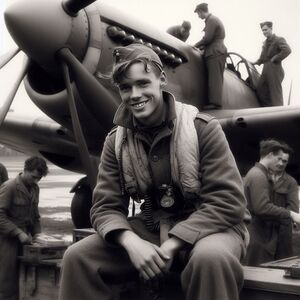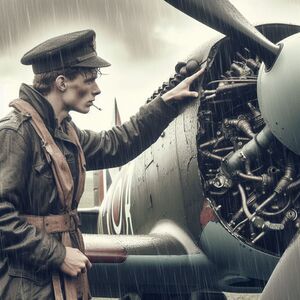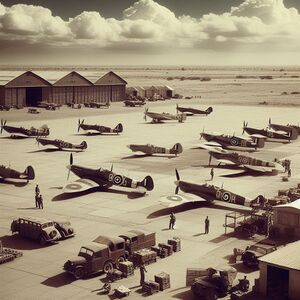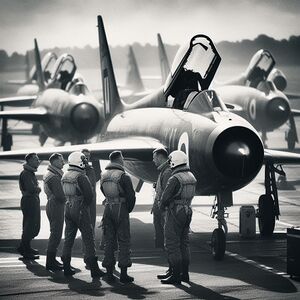Cameron Doyle Greene
Cameron Doyle Greene | |
|---|---|
 Cameron Doyle Greene, photographed in 1938 next to his fighter before operations over The Cape, during the Second Great War. | |
| Nickname(s) | 'Cam-o' |
| Born | 7 June 1915 Chester-on-Moore, Moorden Governorate, Arcerion |
| Died | 1 June 1993 (aged 77) Kinnaird, Arcerion |
| Buried | St. Martin's Cemetery |
| Allegiance | Arcerion |
| Service/ | |
| Years of service | 1935–1943, 1958-1962 |
| Rank | Wing Commander |
| Unit | No.30 Squadron |
| Battles/wars | Second Great War |
| Awards | Arcerion Cross Distinguished Flying Cross |
| Other work | Senior Executive at Aeroco |
Wing Commander Cameron Doyle Green, AC, DFC (7 June 1915 - 1 June 1993) was an Arcerion Air Force (AAF) officer and one of the top Arcer fighter aces of the Second Great War, credited with at least 36 aerial victories.
Born in Chester-on-Moore, Greene volunteered for service originally with the Arcer Army, but a clerical error caused him to be enrolled in the Arcer Air Force. Greene was originally assigned as a navigation officer with No.81 Squadron, transporting heavy goods and soldiers around Arcerion and Crona. After passing pilot's exams, Greene was trained and then assigned to No.30 Squadron, flying interceptor fighters against The Cape and Caphiria. His younger brothers, both paratroopers in the Arcerion Parachute Regiment, were both wounded during actions in The Cape. He flew extensive missions over The Cape, and by 1937 he had already been credited with downing 19 enemy aircraft in combat. Due to exhaustion and combat stress, he was then sent to flight school as an instructor for the majority of 1938.
Greene then went on to be reassigned to No.30 Squadron as the Squadron Commander, and under his command led it through the 1939-1940 period of actions over the Songun Sea. He finished the war with 34 aerial victories. Post-war, he retired as a member of the Air Force Reserve, but was reactivated and promoted as a Wing Commander of No.3 Wing shortly before the Istrenyan Crisis. Greene then went on to earn the Arcerion Cross for his actions during the Istrenyan Crisis, and earning his final two aerial victories, bringing the total to 36 before retiring shortly after the end of the Istrenyan Crisis.
After the conclusion of the Istrenyan Civil War, Greene worked as a pilot for several airlines as a commercial airline pilot, eventually moving into an executive role by the 1980s. With the creation of Aeroco in 1989, he was brought on as a senior executive before he died of natural causes at 73.
Early Life
Cameron Doyle Greene was in Chester-on-Moore, Arcerion, on 7 June 1915, the son of a shipping executive, Eric Yates Greene and his wife, Dorothy née Lancaster, the youngest of six children. He attended several primary and elementary schools, finishing his last six years at South Moorden Men's College, where he finished his formal secondary education. Greene delayed his post-secondary education beliefs as he wished to work and travel Arcerion, and spent much of the next year moving between several jobs, both working for Arcerion Steel Corporation in Easthampton as a foreman, and then Royal Arcerion Fire Service as a firefighter in Easthampton. After this year of varied employment, he began applying to universities and colleges in Arcerion and the Republic of Alstin. Greene performed well on his University entrance exams, and accepted an offer from Ardmori Anglican University, the most prestigious University in Arcerion. At 18, he began an engineering degree for civil engineering, with a minor in philosophy, which he was enrolled in at the outbreak of the Second Great War.
In 1935, with the beginning of hostilities, Greene and his two older brothers went to the recruiting office together over the academic winter holidays to join the Arcer Army. However owing to a clerical error, Greene ended up being enrolled in the Arcer Air Force. His two brothers continued on to both serve as infantry officers in the Royal Arcerion Infantry Corps, both being posted to the Royal Moorden Regiment, and then being transferred to the Arcerion Parachute Regiment at its inception.
Second Great War
Greene's flight training commenced in 1935, and after completing basic officer's training was sent to navigator's school, despite his wishes to serve as a fighter pilot. After passing his navigator's course he was posted to No.81 Squadron as a navigational officer. No.81 Squadron at the time was equipped with military cargo aircraft, assigned to carry men, weapons and equipment in an airlift and support capacity. During the early war period prior to the invasion of The Cape, the Squadron mainly moved supplies from New Archduchy and conducted resupply operations to Howland Governorate under fighter escort.
In 1936, Greene received word that his oldest brother, Captain Arthur Greene (B Company, 1st Battalion, Arcerion Parachute Regiment) was missing in action after a combat jump into The Cape during Operation Lightfoot. Contemporary interviews from members of No.81 Squadron who were close with Greene said this greatly affected his morale. Eventually his brother would be found wounded, and repatriated to Arcerion for recovery.
As Arcerion was relatively isolated in the Second Great War, the need for weapons and equipment rose drastically. Concurrent to this, the growing need to equip multiple divisions of paratroopers and give them the necessary airlift required to insert them into The Cape was skyrocketing. As a navigation officer, Greene worked to plan missions with the pilot and help them fly when visibility was low by calculating their distance, speed, and heading and using new radio technology to assist with their navigation.

With rising hostilities in The Cape and a growing number of fighter pilot and bomber pilot casualties due to the air war over the Songun Sea and ]]The Cape|Capetian islands]], Greene pressured his chain of command to allow him to retake his pilot's exams, and after his successful completion of them, was sent to No.1 Arcer Flight School in Presdale for fighter pilot training. During his four months of training, his staff gave him high marks for integrity, dog fighting skills, mission planning, and physical fitness in calisthenics and running. Towards the end of fighter pilot training, he received a letter from his brother Arthur, informing him that he was home and had been posted to the Chester-on-Moore garrison until his recovered from his wounds. He spent the Christmas of 1936 in Chester-on-Moore on leave with his brother and family, and received orders thereafter to report to No.11 Squadron in Kurst for additional training and to begin his career as a fighter pilot.
No.30 Squadron
As the situation in the Songun Sea began to escalate, especially with the participation of Caphirian fighters and interceptors, pilot losses in combat missions or due to mechanical failures (owing to a high rate of fighter usage) began to rise. Green's posting after fighter school to Kurst meant that after a few weeks of Squadron integration with seven other junior pilots, they were sent to Southern Istrenya to begin air interceptor operations against Capetian maritime patrol aircraft as well as Caphirian long-range bomber interceptors. After landing in Istrenya in mid-March of 1937, the Squadron began patrols over the Western and Southern portions of the Malentine Sea. Greene flew his first combat sortie on March 19th, 1937 and had his first encounter with hostile aircraft on March 22nd, 1937 off the coast of Tierrador. He and his wingman, Flying Officer Bart Weatherborough, engaged a pair of Capetian medium bombers. Firing at both, Greene and Weatherborough claimed one as a shared probable victory, and Greene claimed the other outright after its engine exploded due to repeated machine gun hits from Greene's fighter. The following day, he and Weatherborough encountered another pair of bombers, Green earning his second confirmed victory and Weatherborough his first. In the first week of April, Green's fighter sustained heavy damage after he encountered a Caphirian naval bomber squadron, and its fighter escorts engaged in a dogfight with multiple fighters from No.30 Squadron. Despite the damage, Greene was able to successfully return to Istrenya under his own power.
After twelve weeks of combat flying with multiple victories and the loss of three pilots, No.30 Squadron's planes and pilots were worn out and required rotation. No.30 Squadron was withdrawn to Chester-on-Moore for a leave period of two weeks, during which Greene spent with his family and his other brother in uniform, Eric, who was on leave from operations in The Cape. Collecting replacement pilots for their new deployment, they were sent to the Northern Capetian Islands to participate in operations in The Cape, where the Arcer Army was heavily embattled as the summer of 1937 began to get underway.
The Cape

The Early War, specifically in the The Cape, was marked by fierce fighting throughout much of the Capetian peninsula. Under Operation Cannon, the Arcer Army was driving further inland after a winter of reorganization and restructuring following the success of Operation Lightfoot. Caphirian air attacks, bomber raids, and reconnaisance flights were increasing, as well as the capability and number of aircraft fielded by the Capetian Air Force. Attacks on Arcer shipping transiting the Songun Straits were at an all-time high, and there was a growing threat that the Arcer Army would slow down and be unable to reach Cape Town by the end of 1937. As part of Arcer Fighter Group 1, No.30 Squadron was to be committed to an aggressive aerial campaign to keep the skies open for the Arcer Army on the ground. Later accounts from his comrades and other pilots said that Greene took his duty during this time very seriously, as he felt that he had an obligation to protect his brothers on the ground.
On 8 June 1937 No.30 Squadron intercepted and engaged a Capetian bomber squadron with Caphirian escorts over the Southern Cape during a routine combat air patrol. Greene engaged and destroyed two bombers and a Caphirian fighter, and observed the Caphirian pilot bail out over Arcer lines, where he was presumably captured. The next day, No.30 Squadron intercepted another Capetian bomber squadron, this time without escorts, and the older pre-war vintage bombers fell victim to the faster Arcer planes, with Greene scoring two more victories and a possible. This pattern continued for several weeks, with No.30 Squadron being withdrawn by the end of September for a period of rest and refit, having flown more sorties than any other squadron in Arcer Fighter Group 1. During this time, Flying Officer Bart Weaterborough had been shot down and was missing in action, and Greene's post war interviews said this weighed heavily on him.
No.30 Squadron re-entered the battle in October, operating from a beachhead airfield in The Capetian peninsula. Greene's squadron added further victories to his overall tally, including a pair of Caphirian bombers, a Capetian reconnaissance plane, as well as three Capetian heavy fighters. Bringing his total tally to twelve, making Greene a double ace, this would pale in comparison to 29 October 1937. Greene and No.30 Squadron flew four sorties that day, and it is considered to be the single largest aerial battle in the Second Great War's Cronan Theatre. Commonly referred to by Arcer pilots as 'The Day of Days,' there were no less than four dozen Arcer aircraft lost, and approximately one hundred Capetian and Caphirian aircraft. Greene himself that day scored seven victories, a mixture of fighters and bombers from The Cape and Caphiria, bringing his victory total to nineteen. He was awarded the Distinguished Flying Cross (DFC) for his actions on that day, the published citation reading:
Beginning in March 1937, Flying Officer Greene has flown continuously with No.30 Squadron on offensive and defensive patrols in Istrenya, the Songun Sea, and The Cape. Flying Officer Greene has taken part in numerous engagements against both the Capetian Air Force as well as Caphiria's Imperial Air Defense Force. Flying Officer Greene has protected Arcerion and Burgoignesc shipping, escorted bombers, engaged ground targets in close air support missions, and intercepted enemy bombers heading to attack Arcerion's interests. Flying Officer Greene's tenacity, commitment, courage and skill have contributed in the greatest possible personal extent to the War Effort. It is the Prime Minister's pleasure to award Flying Officer Greene the Distinguished Flying Cross and promotion to the rank of Flight Lieutenant.
No.30 Squadron was reassigned to Arcerion for rest and recuperation, having lost seven more pilots, bringing the active number of capable and ready pilots in the squadron down to five. Greene was reassigned to No.1 Arcer Flight School in Presdale as a fighter pilot instructor.
Flight Instructor
Greene would spend the next several months in Presdale, working with new volunteers and servicemen as part of the fighter pilot training program. He was noted for his emphasis on communication and the usage of radios to communicate between aircraft. During this period, now Flight Lieutenant Greene worked tirelessly, often for sixteen to eighteen hours a day, with maintenance crews on the student trainer aircraft, as well as with other experienced combat pilots on the flight programme and methods of instruction. Greene emphasized the need for more dog fighting and aerial combat tactics to be taught, as he had barely any formal instruction during flight school and had only received a few weeks of introductory training when he first arrived to No.30 Squadron in Kurst two years prior.

During this period, Greene met his future wife, Ashley Upperton, the daughter of a Presdale cattle rancher. The maintained correspondence throughout the war, to eventually be married. In July of 1938, Greene received a letter from his brother, Arthur, informing him that he had been wounded a second time while in combat in the Capetian Peninsula and was to be permanently sent back to Arcerion. Greene took a week leave of absence and travelled by train to receive his brother at his parent's home in Chester-on-Moore. The trip had a significant psychological impact on him, as he felt guilty that he was no longer flying combat missions. Upon returning to Presdale and the fighter school, he immediately began petitioning his chain of command, up to and including a letter to the Chief of Staff of the Arcer Air Force, for a transfer back to Arcer Fighter Group 1. Owing to his fame in the nespapers as a multi-ace, as well as his Distinguished Flying Cross, his request was granted. Green was promoted to Squadron Commander, and replaced the recently wounded Squadron Commander Douglas Rutherford, who had flown with Greene over he Cape in 1937.
Squadron Commander
Returning to No.30 Squadron after Christmas in 1938, Greene noted the low morale in his former unit. They had covered the successful withdrawal of Arcer forces from the Cape following the capitulation of the regime there and been sent to Southern Istrenya to rest and recover. Greene took command of eleven other pilots, all but three of which were fresh from their training and had no experience. Greene and the Squadron were moved in early 1939 to support Burgoignesc forces and other Levantine troops in the Sarpedonian theatre.
The entirety of Arcer Fighter Group 1, as well as Fighter Group 2 were went overseas, and saw daily combat sorties against Caphirian air forces. Beginning with their first sortie June of 1939, Greene scored ten aerial victories from 1 June 1939 to 1 August 1939, bringing his total victories to twenty nine. Due to the ongoing military crisis in Burgundie, Arcer Fighter Group 1 was sent to support Burgundie against the Deric Republic. No.30 Squadron arrived in Burgundie in the fall of 1939, and supported Levantine forces until mid-1940. Due to combat losses and a lack of spare parts, there was a lack of ability to effectively sortie aircraft, leading Greene to petition the Chief of Staff of the Air Force through official channels to rotate experienced pilots back to Arcerion to ensure that the limited flight hours available for combat missions were being given to junior officers who had yet to gain experience. This was ultimately denied, and No.30 Squadron's morale continued to lower as it was able to fly less and less sorties, due to spare parts and maintenance issues owing to the inability to receive timely reinforcement convoys from Crona due to the raging naval war.
By the end of 1940, No.30 Squadron was rotated back to Crona and Arcerion for the remainder of the war, posted to Southern Istrenya. Greene passed command of No.30 Squadron to Squadron Commander John Bates, and was posted to Kurst and the Air Force Operations Staff, where he served the remainder of the war. He assisted with the planning of the air campaign to ensure St. Brendan's Strait remained open. Greene was instrumental in working to have Arcer fighter and interceptor squadrons, as well as maritime patrol aircraft from the Royal Arcerion Naval Service's Naval Air Arm sent to Burgoignesc Equatorial Ostiecia. By posting multiple squadrons, maintenance crews, and logistical facilities at the Burgoignesc airfields there, they were able to shoulder a significant amount of the air combat burden from Burgundie, which was stretched thin between commitments at home in Levantia and the ongoing campaigns in Sarpedon. Greene served with distinction in this staff and planning role until his eventual discharge into the Air Force Reserve in 1943 with the war's end.
Interwar Period
During the interwar period between the Second Great War and the Istrenyan Civil War, Greene worked as a commercial airline pilot for Royal Arcerion Airways. He married Ashley Upperton in 1944, shortly after the war, and the pair moved into a small estate home just outside of Chester-on-Moore. Greene was one of the first commercial airline pilots in Crona to fly a jet airliner, with the Aeroco Comet being adopted by Royal Arcerion Airways. Over time, Greene rose through the corporate ranks after starting as a pilot, eventually by 1957 being the Vice President for Flight Operations. During this period Greene oversaw the merger with South Crona Airlines (1951) as well as the buyout of failing freight airline Songun Freight (1956).
During this period he remained an active member of the Arcer Air Force Reserve, being promoted to the rank of Wing Commander during the period between wars. He flew as a civilian with the Chester Flying and Gliding Club, as well as participating actively in social circles and veteran's organizations in Southern Arcerion. Greene and his wife celebrated the birth of a daughter, Martha, in 1957 shorlty before he was reactivated to rejoin the Arcer Air Force and quitting his job with Royal Arcerion Airways.
The reactivation came as the rising threats of the Occidental Cold War, notably the increasingly aggressive socialist factions in Washakara, Kelekona, and Titechaxha began to actively undermine the sovereignty of Arcerion within the Arcosphere. Greene's first posting was in Chester, as the Air Force Liaision to the Naval Air Arm. There he worked to coordinate between Air Force sorties over the Songun Sea as well as in other areas of South Crona, ensuring there was deconfliction with their Naval Air Arm counterparts.

Istrenyan Crisis
two more aerial victories
upon returning home in 1962, birth of twin sons
Post-War and Later Life
commercial airline pilot
air company executive
founding VP of aeroco
dies peacefully

twin sons, both pilots fight in the Fourth Bush War and Telekonese conflict